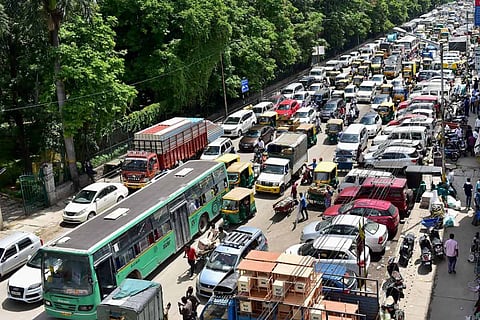

On Sunday, August 29, Karnataka Chief Minister Basavaraj Bommai painted a rosy picture about Bengaluru’s “infamous” traffic mess, which we are all accustomed to. Speaking at the inaugural function of the Purple Line metro extension, the CM said the authorities will ensure a smooth flow of traffic using “seamless signalling with artificial intelligence” on 12 high-density roads of Bengaluru. Yes, AI-enabled smart signals in Bengaluru.
These devices are being installed at 10 major traffic junctions in Bengaluru, mostly within the central business district (CBD) area. According to traffic police officials, the AI-enabled smart signals will have cameras that can ascertain the quantity of the vehicular traffic for different directions and accordingly regulate the time to open and close each signal for traffic. These smart signals can help detect traffic violations, too, as some cameras are equipped to read traffic number plates.
However, subject-matter experts are not completely convinced that this technological intervention alone could be a game-changer in Bengaluru’s traffic system. Instead, they suggest that the state government take proactive steps to encourage public transport.
Ashish Verma, Associate Professor, Transportation Systems Engineering at Indian Institute of Science (IISc) Bengaluru, says that AI traffic signals can only bring short-term improvements, and that too, only in unsaturated traffic conditions. “They have limited impact during saturated traffic conditions, which is the state of traffic in Bengaluru during peak hour travel,” says Ashish, who is also the convenor of Sustainable Transportation Lab.
Pawan Mulukutla, Director- Clean Mobility and Energy Tech, World Resources Institute, India, too, concurred that AI-enabled traffic signals will only have a minimal impact on easing congestion. “Managing traffic intersections is important, and in a city like Bengaluru, which has many such important intersections, good traffic signalling can improve the situation. This will reduce travel by 15-20%, according to recent studies, and ensure optimal flow of traffic. But, is this enough? The answer is no,” Pawan tells TNM.
“We need to build public transport capacities via means such as metro trains and bus priority lanes. Additionally, the officials need to ensure that the design of our roads is uniform, and not just limited to junctions. A road, which is three lanes, gradually becomes two lanes. These changes to the road width result in bottlenecks,” he adds.
According to Ashish, sustainable and long-term improvements to the traffic problems of Bengaluru require strategies to reduce the number of personal vehicles on the roads. “Better and well-maintained roads not just improve the travel time, but can also lead to a reduction in health impacts and traffic injuries,” he says.